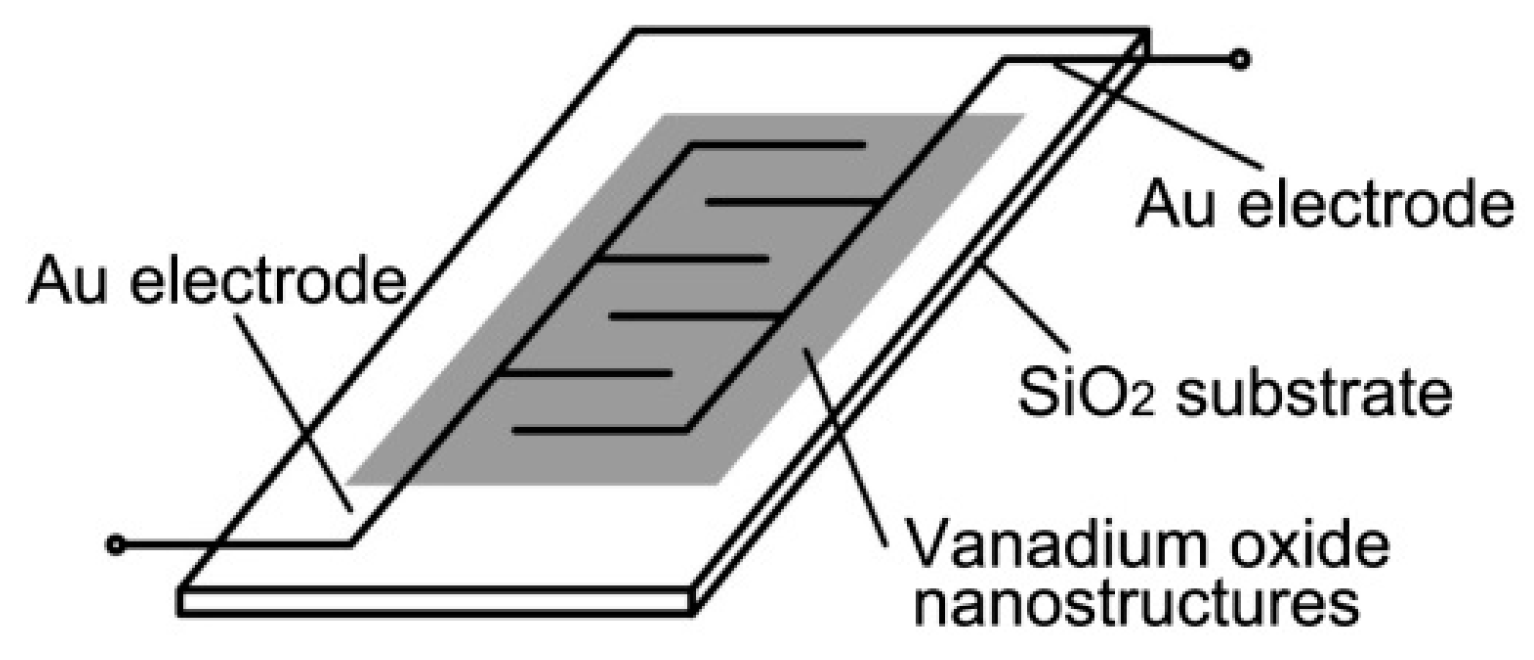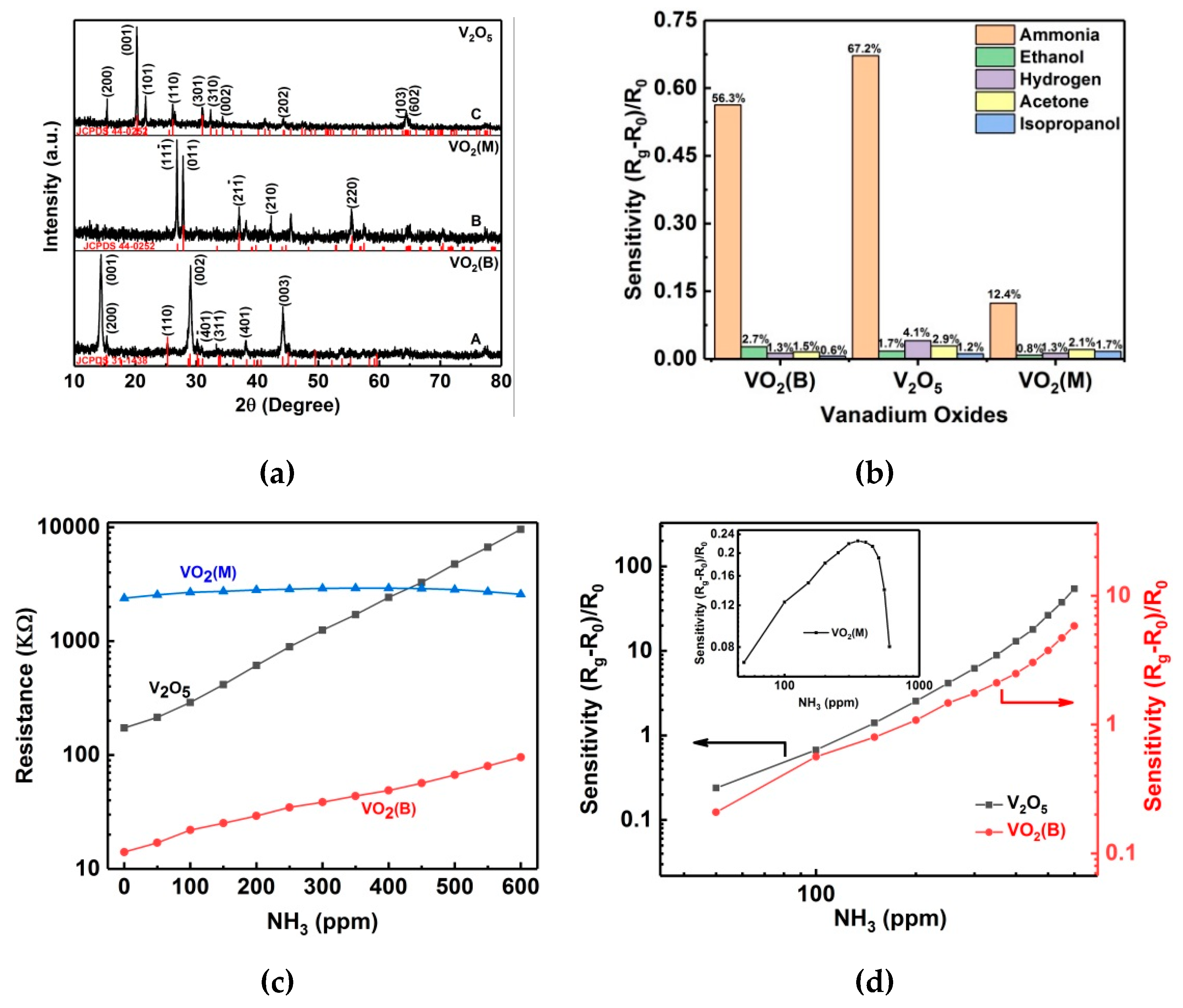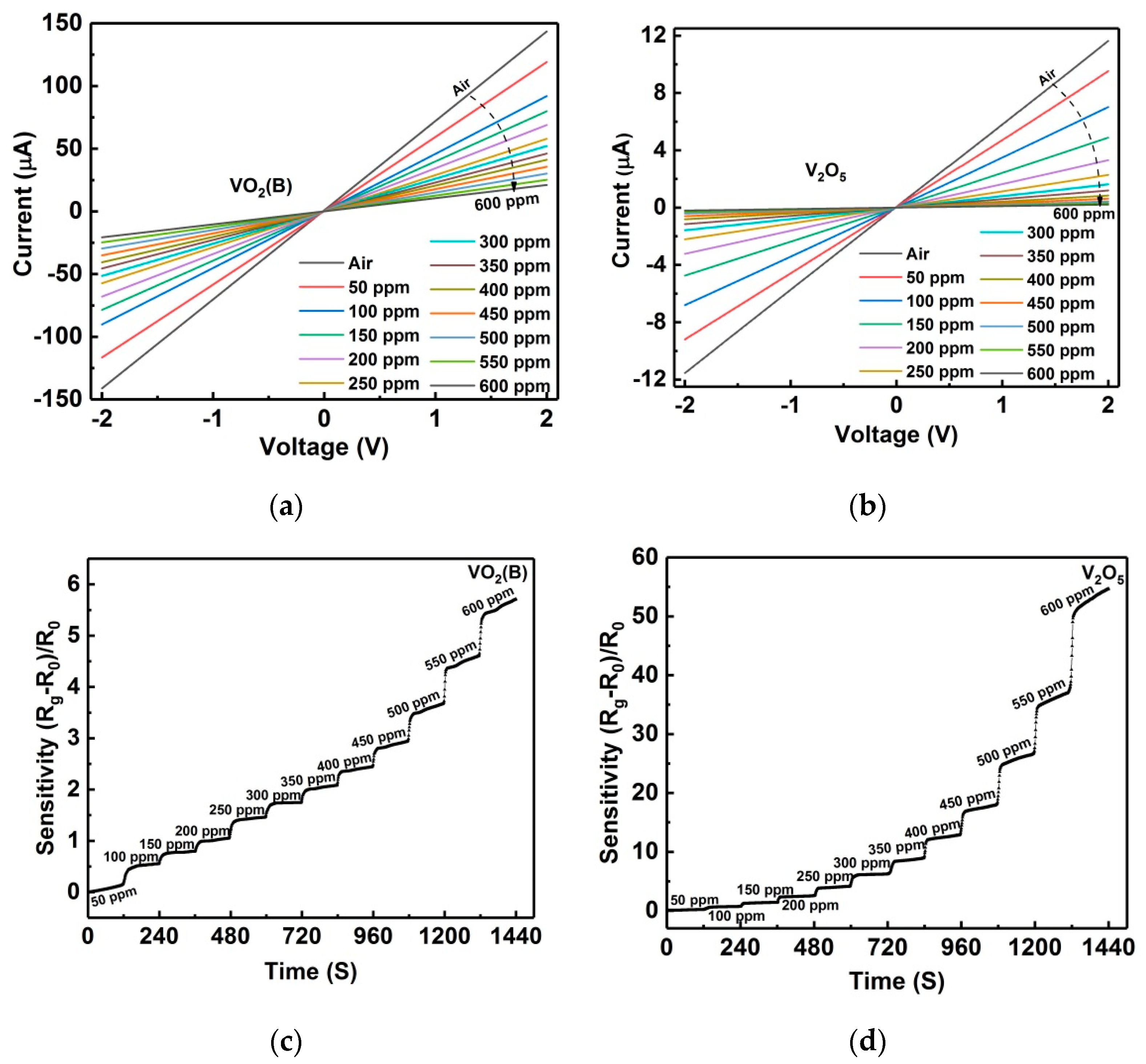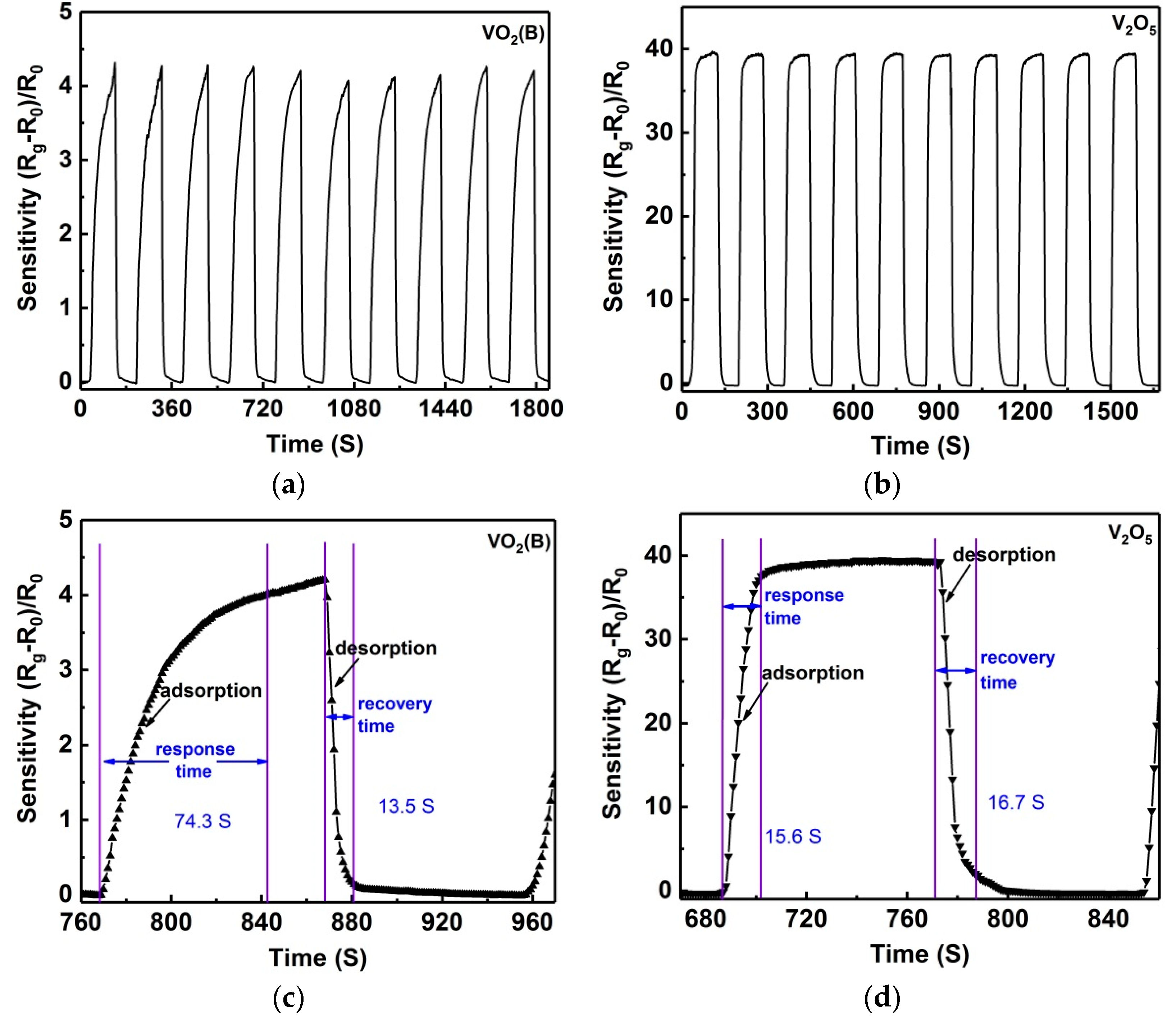Self-Assembled Vanadium Oxide Nanoflakes for p-Type Ammonia Sensors at Room Temperature
Abstract
1. Introduction
2. Materials and Methods
2.1. Synthesis of Self-Assembled Vanadium Oxide Nanoflakes
2.2. Characterization
2.3. Sensor Fabrication and Gas-Sensing Tests
3. Results
4. Conclusions
Author Contributions
Funding
Conflicts of Interest
References
- Wang, Y.; Zhou, Y.; Meng, C.; Gao, Z.; Cao, X.; Li, X.; Xu, L.; Zhu, W.; Peng, X.; Zhang, B.; et al. A high-response ethanol gas sensor based on one-dimensional TiO2/V2O5 branched nanoheterostructures. Nanotechnology 2016, 27, 425503. [Google Scholar] [CrossRef] [PubMed]
- Ju, D.-X.; Xu, H.-Y.; Qiu, Z.-W.; Zhang, Z.-C.; Xu, Q.; Zhang, J.; Wang, J.-Q.; Cao, B.-Q. Near Room Temperature, Fast-Response, and Highly Sensitive Triethylamine Sensor Assembled with Au-Loaded ZnO/SnO2 Core–Shell Nanorods on Flat Alumina Substrates. ACS Appl. Mater. Interfaces 2015, 7, 19163–19171. [Google Scholar] [CrossRef] [PubMed]
- Gurlo, A. Nanosensors: towards morphological control of gas sensing activity. SnO2, In2O3, ZnO and WO3 case studies. Nanoscale 2011, 3, 154–165. [Google Scholar] [CrossRef] [PubMed]
- Sakai, Y.; Kadosaki, M.; Matsubara, I.; Itoh, T. Preparation of total VOC sensor with sensor-response stability for humidity by noble metal addition to SnO2. J. Ceram. Soc. Jpn. 2009, 117, 1297–1301. [Google Scholar] [CrossRef]
- Wang, B.; Deng, L.; Sun, L.; Lei, Y.; Wu, N.; Wang, Y. Growth of TiO2 nanostructures exposed {001} and {110} facets on SiC ultrafine fibers for enhanced gas sensing performance. Sens. Actuat. B: Chem. 2018, 276, 57–64. [Google Scholar] [CrossRef]
- Seekaew, Y.; Wisitsoraat, A.; Phokharatkul, D.; Wongchoosuk, C. Room temperature toluene gas sensor based on TiO2 nanoparticles decorated 3D graphene-carbon nanotube nanostructures. Sens. Actuator B Chem. 2019, 279, 69–78. [Google Scholar] [CrossRef]
- Ganbavle, V.V.; Inamdar, S.I.; Agawane, G.L.; Kim, J.H.; Rajpure, K.Y. Synthesis of fast response, highly sensitive and selective Ni:ZnO based NO2 sensor. Chem. Eng. J. 2016, 286, 36–47. [Google Scholar] [CrossRef]
- Zhang, N.; Yu, K.; Li, Q.; Zhu, Z.Q.; Wan, Q. Room-temperature high-sensitivity H2S gas sensor based on dendritic ZnO nanostructures with macroscale in appearance. J. Appl. Phys. 2008, 103, 104305. [Google Scholar] [CrossRef]
- Mhamdi, A.; Labidi, A.; Souissi, B.; Kahlaoui, M.; Yumak, A.; Boubaker, K.; Amlouk, A.; Amlouk, M. Impedance spectroscopy and sensors under ethanol vapors application of sprayed vanadium-doped ZnO compounds. J. Alloy. Compd. 2015, 639, 648–658. [Google Scholar] [CrossRef]
- Zhang, H.; Wang, Y.; Zhu, X.; Li, Y.; Cai, W. Bilayer Au nanoparticle-decorated WO3 porous thin films: On-chip fabrication and enhanced NO2 gas sensing performances with high selectivity. Sens. Actuator B Chem. 2019, 280, 192–200. [Google Scholar] [CrossRef]
- Mehta, S.S.; Nadargi, D.Y.; Tamboli, M.S.; Chaudhary, L.S.; Patil, P.S.; Mulla, I.S.; Suryavanshi, S.S. Ru-Loaded mesoporous WO3 microflowers for dual applications: Enhanced H2S sensing and sunlight-driven photocatalysis. Dalton Trans. 2018, 47, 16840–16845. [Google Scholar] [CrossRef] [PubMed]
- Yan, S.; Li, Z.; Li, H.; Wu, Z.; Wang, J.; Shen, W.; Fu, Y.Q. Ultra-sensitive room-temperature H2S sensor using Ag-In2O3 nanorod composites. J. Mater. Sci. 2018, 53, 16331–16344. [Google Scholar] [CrossRef]
- Wei, D.; Jiang, W.; Gao, H.; Chuai, X.; Liu, F.; Liu, F.; Sun, P.; Liang, X.; Gao, Y.; Yan, X.; Lu, G. Facile synthesis of La-doped In2O3 hollow microspheres and enhanced hydrogen sulfide sensing characteristics. Sens. Actuator B Chem. 2018, 276, 413–420. [Google Scholar] [CrossRef]
- Chava, R.K.; Cho, H.-Y.; Yoon, J.-M.; Yu, Y.-T. Fabrication of aggregated In2O3 nanospheres for highly sensitive acetaldehyde gas sensors. J. Alloy. Compd. 2019, 772, 834–842. [Google Scholar] [CrossRef]
- Gebicki, J. Application of electrochemical sensors and sensor matrixes for measurement of odorous chemical compounds. TrAC Trends Anal. Chem. 2016, 77, 1–13. [Google Scholar] [CrossRef]
- Spinelle, L.; Gerboles, M.; Kok, G.; Persijn, S.; Sauerwald, T. Review of Portable and Low-Cost Sensors for the Ambient Air Monitoring of Benzene and Other Volatile Organic Compounds. Sensors 2017, 17, 1520. [Google Scholar] [CrossRef] [PubMed]
- Arshak, K.; Moore, E.; Lyons, G.M.; Harris, J.; Clifford, S. A review of gas sensors employed in electronic nose applications. Sens. Rev. 2004, 24, 181–198. [Google Scholar] [CrossRef]
- Röck, F.; Barsan, N.; Weimar, U. Electronic Nose: Current Status and Future Trends. Chem. Rev. 2008, 108, 705–725. [Google Scholar] [CrossRef] [PubMed]
- Szulczyński, B.; Gębicki, J. Currently Commercially Available Chemical Sensors Employed for Detection of Volatile Organic Compounds in Outdoor and Indoor Air. Environments 2017, 4, 21. [Google Scholar] [CrossRef]
- Ureña-Begara, F.; Crunteanu, A.; Raskin, J.-P. Raman and XPS characterization of vanadium oxide thin films with temperature. Appl. Surf. Sci. 2017, 403, 717–727. [Google Scholar] [CrossRef]
- Yin, H.; Yu, K.; Peng, H.; Zhang, Z.; Huang, R.; Travas-Sejdic, J.; Zhu, Z. Porous V2O5 micro/nano-tubes: Synthesis via a CVD route, single-tube-based humidity sensor and improved Li-ion storage properties. J. Mater. Chem. 2012, 22, 5013–5019. [Google Scholar] [CrossRef]
- Lamsal, C.; Ravindra, N.M. Optical properties of vanadium oxides-an analysis. J. Mater. Sci. 2013, 48, 6341–6351. [Google Scholar] [CrossRef]
- Sathiya, M.; Prakash, A.S.; Ramesha, K.; Tarascon, J.M.; Shukla, A.K. V2O5-Anchored Carbon Nanotubes for Enhanced Electrochemical Energy Storage. J. Am. Chem. Soc. 2011, 133, 16291–16299. [Google Scholar] [CrossRef] [PubMed]
- Nethravathi, C.; Rajamathi, C.R.; Rajamathi, M.; Gautam, U.K.; Wang, X.; Golberg, D.; Bando, Y. N-Doped Graphene–VO2(B) Nanosheet-Built 3D Flower Hybrid for Lithium Ion Battery. ACS Appl. Mater. Interfaces 2013, 5, 2708–2714. [Google Scholar] [CrossRef] [PubMed]
- Yao, T.; Liu, L.; Xiao, C.; Zhang, X.; Liu, Q.; Wei, S.; Xie, Y. Ultrathin Nanosheets of Half-Metallic Monoclinic Vanadium Dioxide with a Thermally Induced Phase Transition. Angew. Chem. Int. Ed. 2013, 52, 7554–7558. [Google Scholar] [CrossRef] [PubMed]
- Li, Z.; Hu, Z.; Peng, J.; Wu, C.; Yang, Y.; Feng, F.; Gao, P.; Yang, J.; Xie, Y. Ultrahigh Infrared Photoresponse from Core–Shell Single-Domain-VO2/V2O5 Heterostructure in Nanobeam. Adv. Funct. Mater. 2014, 24, 1821–1830. [Google Scholar] [CrossRef]
- Mane, A.A.; Moholkar, A.V. Effect of film thickness on NO2 gas sensing properties of sprayed orthorhombic nanocrystalline V2O5 thin films. Appl. Surf. Sci. 2017, 416, 511–520. [Google Scholar] [CrossRef]
- Yan, W.; Hu, M.; Wang, D.; Li, C. Room temperature gas sensing properties of porous silicon/V2O5 nanorods composite. Appl. Surf. Sci. 2015, 346, 216–222. [Google Scholar] [CrossRef]
- Qin, Y.; Fan, G.; Liu, K.; Hu, M. Vanadium pentoxide hierarchical structure networks for high performance ethanol gas sensor with dual working temperature characteristic. Sens. Actuator B Chem. 2014, 190, 141–148. [Google Scholar] [CrossRef]
- Wang, R.; Yang, S.; Deng, R.; Chen, W.; Liu, Y.; Zhang, H.; Zakharova, G.S. Enhanced gas sensing properties of V2O5 nanowires decorated with SnO2 nanoparticles to ethanol at room temperature. RSC Adv. 2015, 5, 41050–41058. [Google Scholar] [CrossRef]
- Dhayal Raj, A.; Pazhanivel, T.; Suresh Kumar, P.; Mangalaraj, D.; Nataraj, D.; Ponpandian, N. Self assembled V2O5 nanorods for gas sensors. Curr. Appl. Phys. 2010, 10, 531–537. [Google Scholar] [CrossRef]
- Yang, X.H.; Xie, H.; Fu, H.T.; An, X.Z.; Jiang, X.C.; Yu, A.B. Synthesis of hierarchical nanosheet-assembled V2O5 microflowers with high sensing properties towards amines. RSC Adv. 2016, 6, 87649–87655. [Google Scholar] [CrossRef]
- Huotari, J.; Bjorklund, R.; Lappalainen, J.; Lloyd Spetz, A. Pulsed Laser Deposited Nanostructured Vanadium Oxide Thin Films Characterized as Ammonia Sensors. Sens. Actuator B Chem. 2015, 217, 22–29. [Google Scholar] [CrossRef]
- Modafferi, V.; Trocino, S.; Donato, A.; Panzera, G.; Neri, G. Electrospun V2O5 composite fibers: Synthesis, characterization and ammonia sensing properties. Thin Solid Films 2013, 548, 689–694. [Google Scholar] [CrossRef]
- Modafferi, V.; Panzera, G.; Donato, A.; Antonucci, P.L.; Cannilla, C.; Donato, N.; Spadaro, D.; Neri, G. Highly sensitive ammonia resistive sensor based on electrospun V2O5 fibers. Sens. Actuator B Chem. 2012, 163, 61–68. [Google Scholar] [CrossRef]
- Hakim, S.A.; Liu, Y.; Zakharova, G.S.; Chen, W. Synthesis of vanadium pentoxide nanoneedles by physical vapour deposition and their highly sensitive behavior towards acetone at room temperature. RSC Adv. 2015, 5, 23489–23497. [Google Scholar] [CrossRef]
- Yu, M.; Liu, X.; Wang, Y.; Zheng, Y.; Zhang, J.; Li, M.; Lan, W.; Su, Q. Gas sensing properties of p-type semiconducting vanadium oxide nanotubes. Appl. Surf. Sci. 2012, 258, 9554–9558. [Google Scholar] [CrossRef]
- Evans, G.P.; Powell, M.J.; Johnson, I.D.; Howard, D.P.; Bauer, D.; Darr, J.A.; Parkin, I.P. Room temperature vanadium dioxide–carbon nanotube gas sensors made via continuous hydrothermal flow synthesis. Sens. Actuator B Chem. 2018, 255, 1119–1129. [Google Scholar] [CrossRef]
- Yin, H.; Yu, K.; Zhang, Z.; Zhu, Z. Morphology-control of VO2(B) nanostructures in hydrothermal synthesis and their field emission properties. Appl. Surf. Sci. 2011, 257, 8840–8845. [Google Scholar] [CrossRef]
- Gurlo, A.; Bârsan, N.; Ivanovskaya, M.; Weimar, U.; Göpel, W. In2O3 and MoO3–In2O3 thin film semiconductor sensors: interaction with NO2 and O3. Sens. Actuator B Chem. 1998, 47, 92–99. [Google Scholar] [CrossRef]
- Lu, Q.; Bishop, S.R.; Lee, D.; Lee, S.; Bluhm, H.; Tuller, H.L.; Lee, H.N.; Yildiz, B. Electrochemically Triggered Metal–Insulator Transition between VO2 and V2O5. Adv. Funct. Mater. 2018, 28, 1803024. [Google Scholar] [CrossRef]
- Srivastava, A.; Rotella, H.; Saha, S.; Pal, B.; Kalon, G.; Mathew, S.; Motapothula, M.; Dykas, M.; Yang, P.; Okunishi, E.; Sarma, D.D.; Venkatesan, T. Selective growth of single phase VO2(A, B, and M) polymorph thin films. APL Mater. 2015, 3, 026101. [Google Scholar] [CrossRef]
- Amos Adeleke, A.; Augusto Goncalo Jose, M.; Bathusile, M.; George, C.; Boitumelo, M.; Kittessa, R.; Mart-Mari, D.; Hendrik, S.; Jayita, B.; Suprakas Sinha, R.; et al. Blue- and red-shifts of V2O5 phonons in NH3 environment by in situ Raman spectroscopy. J. Phys. D Appl. Phys. 2018, 51, 015106. [Google Scholar]
- Liu, J.; Wang, X.; Peng, Q.; Li, Y. Preparation and gas sensing properties of vanadium oxide nanobelts coated with semiconductor oxides. Sens. Actuator B Chem. 2006, 115, 481–487. [Google Scholar] [CrossRef]
- Fu, H.; Yang, X.; An, X.; Fan, W.; Jiang, X.; Yu, A. Experimental and theoretical studies of V2O5@TiO2 core-shell hybrid composites with high gas sensing performance towards ammonia. Sens. Actuator B Chem. 2017, 252, 103–115. [Google Scholar] [CrossRef]
- Bannov, A.G.; Prášek, J.; Jašek, O.; Shibaev, A.A.; Zajíčková, L. Investigation of Ammonia Gas Sensing Properties of Graphite Oxide. Procedia Eng. 2016, 168, 231–234. [Google Scholar] [CrossRef]
- Urasinska-Wojcik, B.; Gardner, J.W. H2S Sensing in Dry and Humid H2 Environment With p-Type CuO Thick-Film Gas Sensors. IEEE Sens. J. 2018, 18, 3502–3508. [Google Scholar] [CrossRef]







| Properties of Vanadium Oxides | VO2(B) | VO2(M) | V2O5 |
|---|---|---|---|
| Crystal Structure | Monoclinic (C2/m) a = 12.03, b = 3.693, c = 6.42, β = 106.6° | Monoclinic (P21/c) a = 5.753, b = 4.526, c = 5.383, β = 122.6° | Orthorhombic (Pmmn) a = 11.516, b = 3.566, c = 4.373 |
| Structural/Physical/Chemical Characteristics | Layer structure | Rapid reversible MIT (340 K) Drastic change in resistivity and optical transparency between MIT | Layer structure Oxidizing Enhanced surface reactivity |
| Applications | Energy storage materials Sensors | Chromogenic materials High-speed electronics | Chromogenic materials Catalysts Energy storage materials Sensors |
| Vanadium Oxides | Resistive Response | Response Time | Recovery Time |
|---|---|---|---|
| VO2(B) nanoflakes * | 0.21 (50 ppm) 5.82 (600 ppm) | 63–85 s (550 ppm) | 11–16 s (550 ppm) |
| V2O5 nanoflakes * | 0.24 (50 ppm) 54.4 (600 ppm) | 14–22 s (550 ppm) | 14–20 s (550 ppm) |
| VO2(B) nanoparticles [38] | 0.1 (45 ppm) | 310 s | 40 min |
| V2O5 films [43] | 0.419 (40 ppm) | 59 s | − |
| V2O5 nanobelts [44] | 0.7 (100 ppm) | 32 s | 30 s |
| V2O5 fibers [35] | − | 50 s (0.85–45 ppm) | 350 s (0.85–45 ppm) |
| V2O5 nanoparticles [45] | ~2.0 (200 ppm) | 23 s | 13 s |
© 2019 by the authors. Licensee MDPI, Basel, Switzerland. This article is an open access article distributed under the terms and conditions of the Creative Commons Attribution (CC BY) license (http://creativecommons.org/licenses/by/4.0/).
Share and Cite
Yin, H.; Song, C.; Wang, Z.; Shao, H.; Li, Y.; Deng, H.; Ma, Q.; Yu, K. Self-Assembled Vanadium Oxide Nanoflakes for p-Type Ammonia Sensors at Room Temperature. Nanomaterials 2019, 9, 317. https://doi.org/10.3390/nano9030317
Yin H, Song C, Wang Z, Shao H, Li Y, Deng H, Ma Q, Yu K. Self-Assembled Vanadium Oxide Nanoflakes for p-Type Ammonia Sensors at Room Temperature. Nanomaterials. 2019; 9(3):317. https://doi.org/10.3390/nano9030317
Chicago/Turabian StyleYin, Haihong, Changqing Song, Zhiliang Wang, Haibao Shao, Yi Li, Honghai Deng, Qinglan Ma, and Ke Yu. 2019. "Self-Assembled Vanadium Oxide Nanoflakes for p-Type Ammonia Sensors at Room Temperature" Nanomaterials 9, no. 3: 317. https://doi.org/10.3390/nano9030317
APA StyleYin, H., Song, C., Wang, Z., Shao, H., Li, Y., Deng, H., Ma, Q., & Yu, K. (2019). Self-Assembled Vanadium Oxide Nanoflakes for p-Type Ammonia Sensors at Room Temperature. Nanomaterials, 9(3), 317. https://doi.org/10.3390/nano9030317





